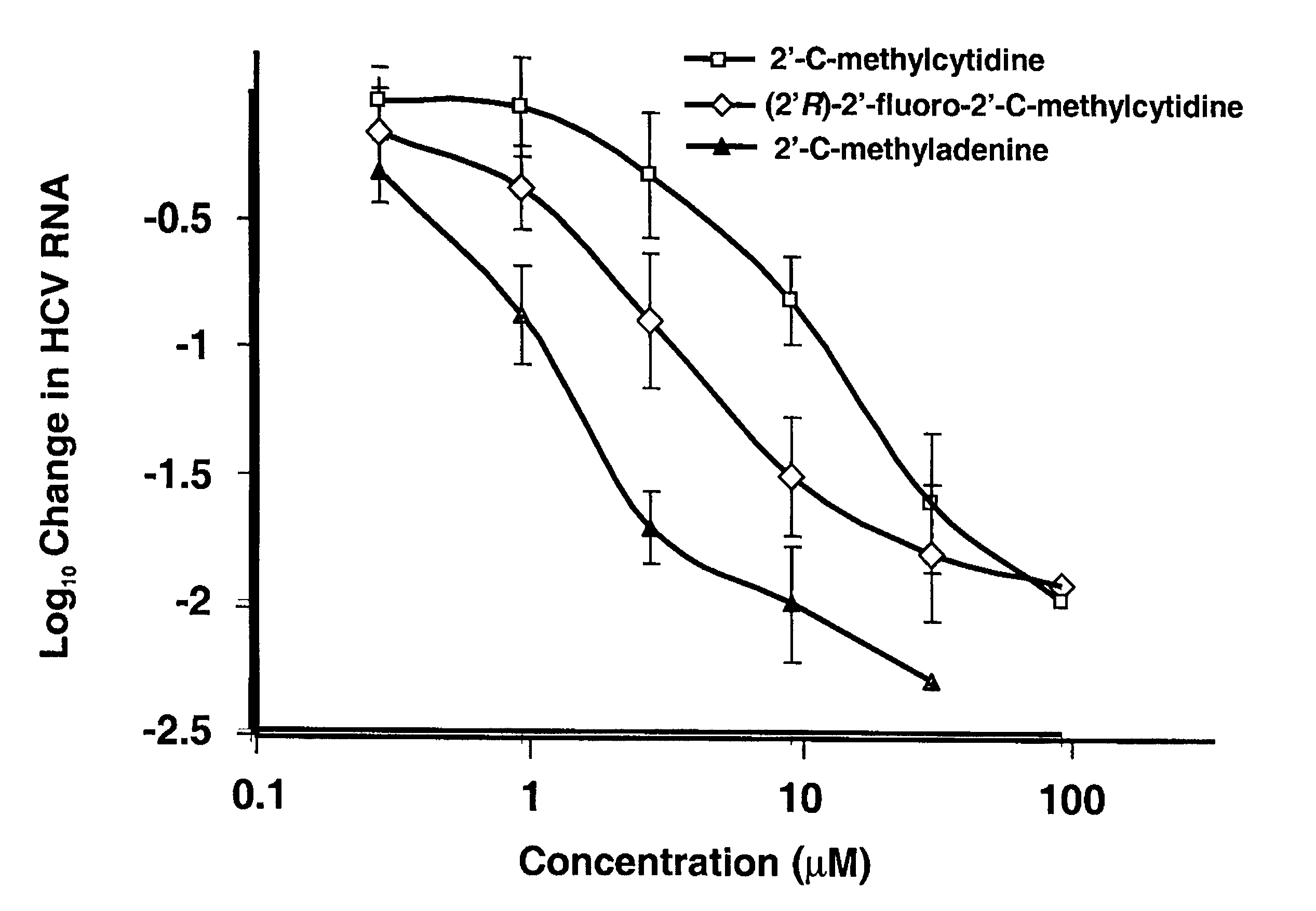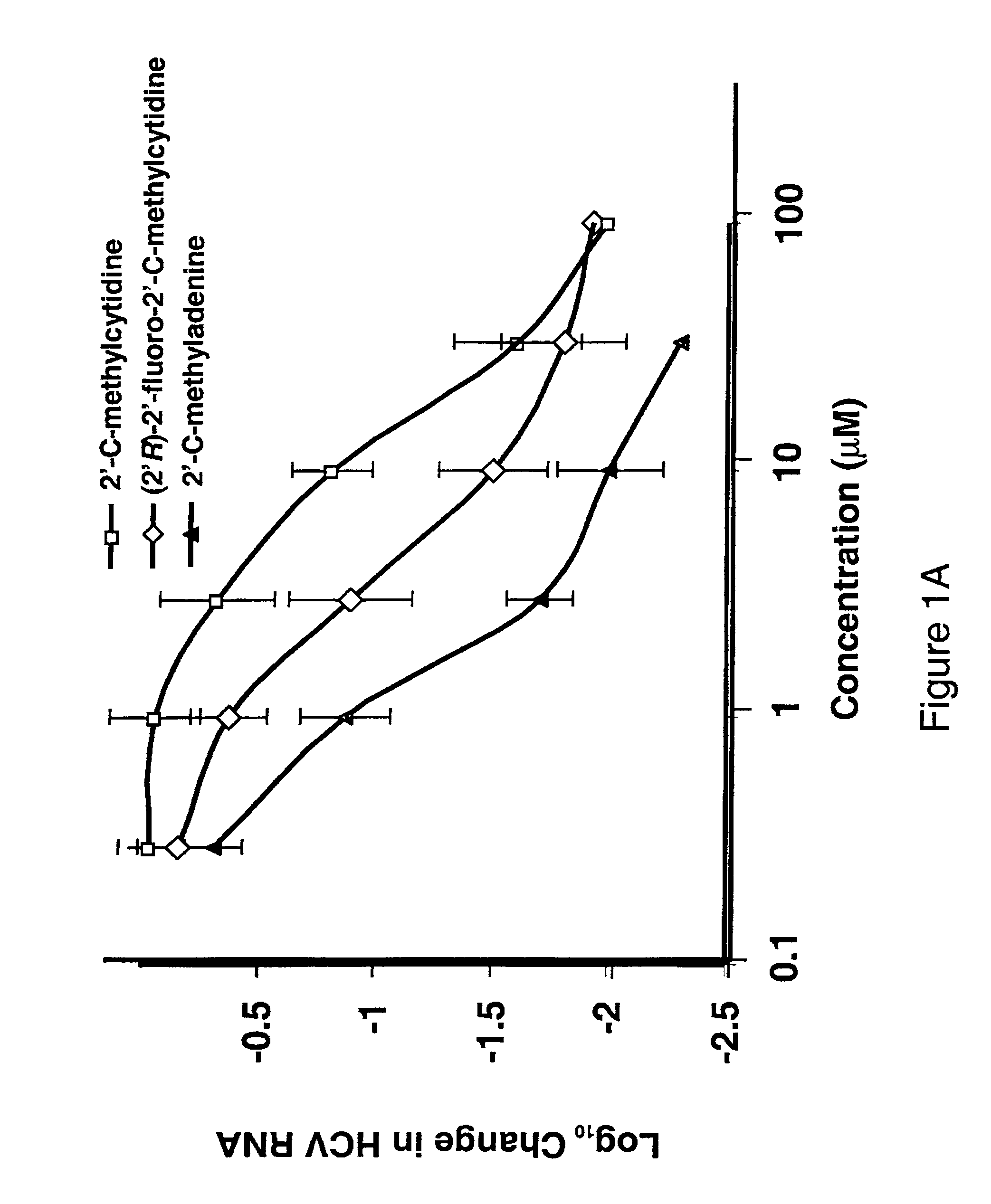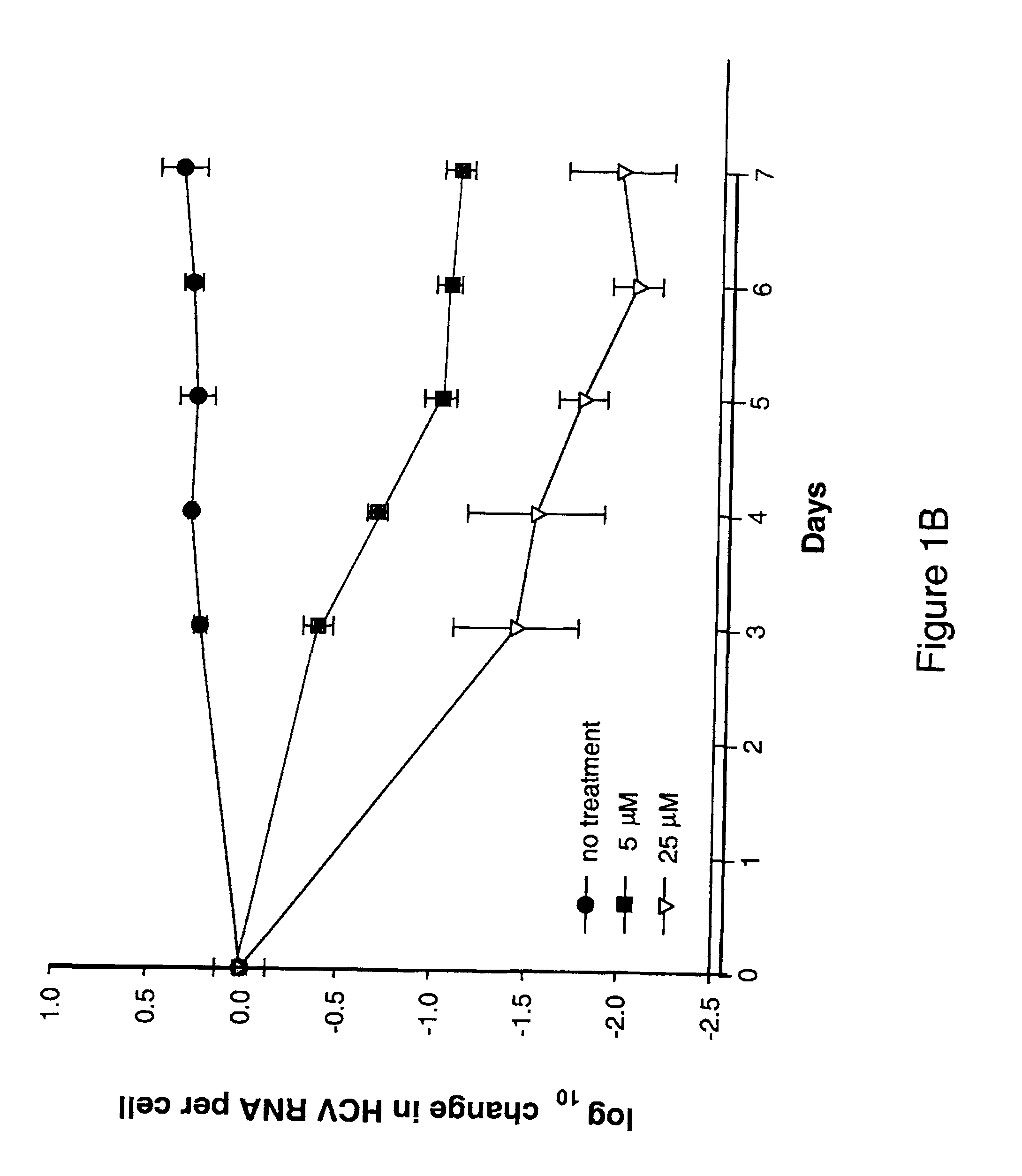Modified fluorinated nucleoside analogues
a technology of fluorinated nucleosides and analogues, which is applied in the field of flaviviridae infections, can solve the problems of limited hcv therapy, no preventive treatment, and currently approved therapies, and achieve the effect of reducing toxicity and great specificity for hepatitis c virus
- Summary
- Abstract
- Description
- Claims
- Application Information
AI Technical Summary
Benefits of technology
Problems solved by technology
Method used
Image
Examples
example 1
Synthesis of (2′R)-2′-Deoxy-2′-Fluoro-2′-C-Methylcytidine Starting from a Carbohydrate
[0275]
[0276] Step 1: Compound 3-1 (7.7 g, 0.022 mmol) was dissolved in anhydrous diethyl ether and cooled to −78° C. To this solution was added MeLi (30 mL, 1.6 M in diethyl ether). After the reaction was complete, the mixture was treated with ammonium chloride (1 M, 65 mL) and the organic phase was separated, dried (Na2SO4), filtered, and concentrated to dryness. Silica gel chromatography followed by crystallization from diethyl ether-hexanes afforded pure compound 3-2 (6.31 g). 1H NMR (400 MHz, CDCl3): δ 1.40 (s, 3H), 3.41 (s, 3H), 3.49 (dd, 1H, J=10.3, 6.89 Hz), 3.57 (dd, 1H, J=10.3, 3.88 Hz), 3.84 (d, 1H, J=7.3 Hz), 4.03 (m, 1H), 4.48 (s, 1H), 4.58 (m, 3H), 4.83 (d, 1H, J=11.6 Hz), 7.31-7.36 (m, 10H); 13C NMR (100 MHz, CDCl3): δ 18.4, 55.4, 72.2, 73.4, 79.5, 80.2, 84.7, 107.4, 127.7, 127.8, 127.83, 128.5, 138.2, 138.3.
[0277] Step 2: Compound 3-2 was dissolved in CH2Cl2 and was treated with DA...
example 2
Synthesis of (2′R)-2′-Deoxy-2′-Fluoro-2′-C-Methylcytidine Starting from Cytidine
[0281][0282] TIDPS=1,3-(1,1,3,3-Tetraisopropyldisiloxanylidene)
[0283] Step 1: To a suspension of cytidine (100 g, 0.411 mol) in DMF (2.06 L) is added benzoic anhydride (102.4 g, 0.452 mol). The mixture was stirred at room temperature for 20 h. The DMF was removed in vacuo and the residue was triturated with diethyl ether. The resulting solid was collected by suction filtration and washed with diethyl ether (2×200 mL). Further drying in vacuo at room temperature gave the N4 benzamide (140.6 g, 98.3%). A portion of this material (139.3 g, 0.401 mol) was dissolved in anhydrous pyridine (1.2 L) and was treated with 1,3-dichloro-1,1,3,3-tetraisopropyl-disiloxane (141.4 mL, 0.441 mol) at room temp. The solution was stirred at room temperature overnight. The mixture was concentrated to near dryness in vacuo and coevaporated with toluene (3×200 mL). The residue was treated with EtOAc (1.8 L) and washed with HC...
example 3
Synthesis of (2′R)-6-Chloro-2′-Deoxy-2′-Fluoro-2′-C-Methylpurine Starting from 6-Chloropurine Riboside
[0290]
[0291] Step 1: The nucleoside, 6-chloropurine riboside, (3.18 g, 11.09 mmol) was dissolved in anhydrous pyridine (300 mL) and was treated dropwise with 1,3-dichloro-1,1,3,3-tetraisopropyl-disiloxane (4.08 mL, 12.75 mmol) at 0° C. under an argon atmosphere. The solution was brought to room temp and stirred overnight. The mixture was concentrated to near dryness in vacuo, dissolved in a minimal amount of chloroform, and washed with HCl (100 mL, 0.05 N) and NaHCO3 (5%, 100 mL). The organic layer was dried (Na2SO4), filtered, and evaporated to dryness to afford compound 5-1 as an amber glass (6.10 g, >100%) that was used without further purification. 1H NMR (CDCl3): δ 1.01-1.13 (m, 24H), 4.03-4.18 (m, 3H), 4.58 (d, 1H, J=5.2 Hz), 5.01 (m, 1H), 6.07 (s, 1H), 8.31 (s, 1H), 8.71 (s, 1H).
[0292] Step 2: Compound 5-1 (7.13 g, 13.47 mmol) was dissolved in dry THF (35 mL). Anhydrous DMS...
PUM
| Property | Measurement | Unit |
|---|---|---|
| concentration | aaaaa | aaaaa |
| temperatures | aaaaa | aaaaa |
| resistance | aaaaa | aaaaa |
Abstract
Description
Claims
Application Information
 Login to View More
Login to View More - R&D
- Intellectual Property
- Life Sciences
- Materials
- Tech Scout
- Unparalleled Data Quality
- Higher Quality Content
- 60% Fewer Hallucinations
Browse by: Latest US Patents, China's latest patents, Technical Efficacy Thesaurus, Application Domain, Technology Topic, Popular Technical Reports.
© 2025 PatSnap. All rights reserved.Legal|Privacy policy|Modern Slavery Act Transparency Statement|Sitemap|About US| Contact US: help@patsnap.com



